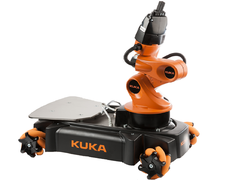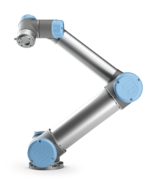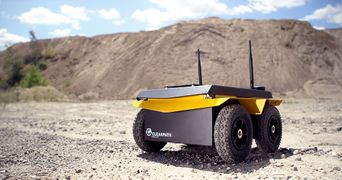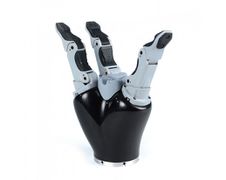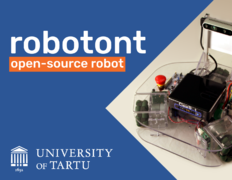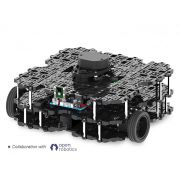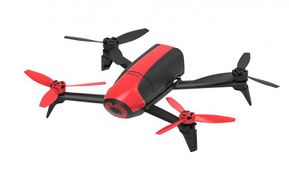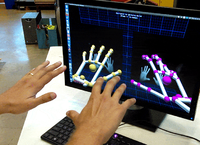Theses in Robotics: Difference between revisions
| Line 118: | Line 118: | ||
=== Navigator PYRX: Python-based motion planning for ROS2 Navigation software stack === | === Navigator PYRX: Python-based motion planning for ROS2 Navigation software stack === | ||
ROS Navigation provides off-the-shelf tools for making mobile robots autonomous (including the use established motion planning algorithms). However, the software architecture requires the motion planning algorithms to be implemented as C++ plugins. In reality, many motion planning algorithms are first implemented using Python libraries, thus, there is great demand for plugging Python-based motion planning algorithms in ROS Navigation. The thesis seeks to design and develop the software solution for that particular goal. | ROS Navigation provides off-the-shelf tools for making mobile robots autonomous (including the use established motion planning algorithms). However, the software architecture requires the motion planning algorithms to be implemented as C++ plugins. In reality, many motion planning algorithms are first implemented using Python libraries, thus, there is great demand for plugging Python-based motion planning algorithms in ROS Navigation. The thesis seeks to design and develop the software solution for that particular goal. | ||
<hr> | |||
=== Vision-based pick-and-place demo with xArm7 === | |||
ROS and MoveIt are used to demonstrate how an unorganized pile of objects is picked by an xArm7 robot and ordered into a box or tray. The system integrates a depth camera to detect 3D environment of the robot and track objects. | |||
<hr> | <hr> | ||
Revision as of 13:10, 17 August 2022
Projects in Advanced Robotics
The main objective of the follwing projects is to give students experience in working with advanced robotics tehcnology. Our group is active in several R&D projects involving human-robot collaboration, intuitive teleoperation of robots, and autonomous navigation of unmanned mobile platforms. Our main software platforms are Robot Operating System (ROS) for developing software for advanced robot systems and Gazebo for running realistic robotic simulations.
For further information, contact Karl Kruusamäe and Arun Kumar Singh
The following is not an exhaustive list of all available thesis/research topics.
Highlighted theses topics for 2022/2023 study year
- ROBOTONT: COTS battery support for robotont
- ROS2 learning materials for MoveIt
- Navigator PYRX: Python-based motion planning for ROS2 Navigation software stack
- Stratos Explore Ultraleap demonstrator for robotics
- ROBOTONT: ROS2 support for robotont
- Mixed-reality scene creation for vehicle teleoperation
List of potential thesis topics
Our inventory includes but is not limited to:
ROBOTONT: ROS support, demos, and educational materials for open-source mobile robot
The project involves many potential theses topic on open-source robot platform ROBOTONT. The nature of the thesis can be software development to improve the platform's capabilites, simulation of specific scenarios, and/or demonstration of ROBOTONT in real-life setting. A more detailed thesis topic will be outlined during in-person meeting

Virtual reality user interface (VRUI) for intuitive teleoperation system
Enhancing the user-experience of a virtual reality UI developed by Georg Astok. Potentially adding virtual reality capability to a gesture- and natural-language-based robot teleoperation system.
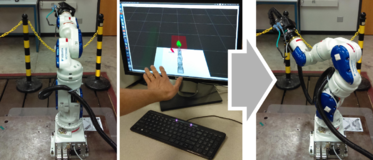
Health monitor for intuitive telerobot
Intelligent status and error handling for an intuitive telerobotic system.
3D scanning of industrial objects
Using laser sensors and cameras to create accurate models of industrial products for quality control or further processing.
Modeling humans for human-robot interaction
True human-robot collaboration means that the robot must understand the actions, intention, and state of its human partner. This work invovlves using cameras and other human sensors for digitally representing and modelling humans. There are multiple stages for modeling: a) physical models of human kinematics and dynamics; b) higher level-models for recognizing human intent.
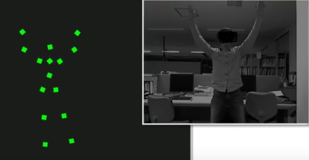
Robotic avatar for telepresence
Integrating hand gestures and head movements to control a robot avatar in virtual reality user interface.
Detection of hardware and software resources for smart integration of robots
Vast majority of today’s robotic applications rely on hard-coded device and algorithm usage. This project focuses on developing a Resource Snooper software, that can detect addition or removal of resources for the benefit of dynamic reconfiguration of robotic systems. This project is developed as a subsystem of TeMoto.
Sonification of feedback during teleoperation of robots
Humans are used to receiving auditory feedback in their everyday lives. It helps us make decision and be aware of potential dangers. Telerobotic interfaces can deploy the same idea to improve the Situational Awareness and robotic task efficiency. The thesis project involves a study about different sonification solutions and implementation of it in a telerobotic application using ROS.
Human-Robot and Robot-Robot collaboration applications
Creating a demo or analysis of software capabilities related to human-robot or tobot-robot teams
- human-robot collaborative assembly
- distributed mapping; analysis and demo of existing ROS (e.g., segmap https://youtu.be/JJhEkIA1xSE) packages for multi-robot mapping
- Inaccessible region teamwork
- youbot+drone - a drone maps the environment (for example a maze) and ground vehicle uses this information to traverse the maze
- youbot+clearbot - youbot cannot go up ledges but it can lift smaller robot, such as clearbot, up a ledge.
Developing ROS driver for a robotic gripper
The goal for this project is to develop ROS drivers for LEHF32K2-64 gripper. The work is concluded by demonstrating the functionalities of the gripper via pick-and-place task.

Mirroring human hand movements on industrial robots
The goal of this project is to integrate continuous control of industrial robot manipulator with a gestural telerobotics interface. The recommended tools for this thesis project are Leap Motion Controller or a standard web camera, Ultraleap, Universal Robot UR5 manipulator, and ROS.
ROBOTONT: TeMoto for robotont
Swarm-management for robotont using TeMoto framework.
Enhancing teleoperation control interface with augmented cues to provoke caution
The task is to create a telerobot control interface where video feed from the remote site and/or a mixed-reality scene is augmented with visual cues to provoke caution in human operator.
Robot-to-human interaction
As robots and autonomous machines start sharing the same space a humans, their actions need to be understood by the people occupying the same space. For instance, a human worker needs to understand what the robot partner is planning next or a pedestrian needs to clearly comprehend the behaviour of a driverless vehicle. To reduce the ambiguity, the robot needs mechanisms to convey its intent (whatever it is going to do next). The aim of the thesis is to outline existing methods for machines to convey their intent and develop a unified model interface for expressing that intent.
Gaze-based handover prediction
When human needs to pass an object to a robot manipulator, the robot must understand where in 3D space the object handover occurs and then plan an appropriate motion. Human gaze can be used as the input for predicting which object to track. This thesis activities involve camera-based eye tracking and safe motion-planning.
Real-world demonstrator for MIR+UR+TeMoto integration
Integration of mobile manipulator (MIR100 + UR5e + Robotiq gripper) to demonstrate TeMoto in a collaborative application.
ROBOTONT: Human-height human-robot interface for Robotont ground robot
Robotont is an ankle-high flat mobile robot. For humans to interact with Robotont, there is a need for a compact and lightweight mechanical structure that is tall enough for comfortable human-robot interaction. The objective of the thesis is to develop the mechanical designs and build prototypes that ensure stable operation and meet the aesthetic requirements for use in public places.
Stratos Explore Ultraleap demonstrator for robotics
The aim of this thesis is to systematically analyze the strengths and limitations of the Stratos Explore Ultraleap device in the context of controlling a robot. Subsequently implement a demonstrator application for showing off its applicability for robot control.
Continuous teleopearation setup for controlling mobile robot on streets
The task in this device is analyse available options for building a teleopearation cockpit for continously controlling a mobile robot moving on the streets. The contribution of the thesis is to set up the system, validate its usability, and benchmark its capabilities/limitations.
ROBOTONT: ROS2 support for robotont
Creating ROS2 support for robotont mobile platform
ROBOTONT: COTS battery support for robotont
Redisgning the body and power supply electronics for Robotont to support commercially available battery solution.
Mixed-reality scene creation for vehicle teleoperation
Fusing different sensory feeds for creating high-usability teleoperation scene.
Validation study for AR-based robot user-interfaces
Designing and carrying out a user study to validate the functionality and usability of an human-robot interface.
ROS2 learning materials for MoveIt
Porting the learnng content and code examples of how to control manipulator robots from ROS1 to ROS2.
ROS Navigation provides off-the-shelf tools for making mobile robots autonomous (including the use established motion planning algorithms). However, the software architecture requires the motion planning algorithms to be implemented as C++ plugins. In reality, many motion planning algorithms are first implemented using Python libraries, thus, there is great demand for plugging Python-based motion planning algorithms in ROS Navigation. The thesis seeks to design and develop the software solution for that particular goal.
Vision-based pick-and-place demo with xArm7
ROS and MoveIt are used to demonstrate how an unorganized pile of objects is picked by an xArm7 robot and ordered into a box or tray. The system integrates a depth camera to detect 3D environment of the robot and track objects.
Completed projects
Masters's theses
- Igor Rybalskii, Augmented reality (AR) for enabling human-robot collaboration with ROS robots [Liitreaalsus inimese ja roboti koostöö võimaldamiseks ROS-i robotitega], MS thesis, 2022
- Md. Maniruzzaman, Object search and retrieval in indoor environment using a Mobile Manipulator [Objektide otsimine ja teisaldamine siseruumides mobiilse manipulaatori abil], MS thesis, 2022
- Allan Kustavus, Design and Implementation of a Generalized Resource Management Architecture in the TeMoto Software Framework [Üldise ressursihalduri disain ja teostus TeMoto tarkvara raamistikule], MS thesis, 2021
- Kristina Meister, External human-vehicle interaction - a study in the context of an autonomous ride-hailing service, MS thesis, 2021
- Muhammad Usman, Development of an Optimization-Based Motion Planner and Its ROS Interface for a Non-Holonomic Mobile Manipulator [Optimeerimisele baseeruva liikumisplaneerija arendamine ja selle ROSi liides mitteholonoomse mobiilse manipulaatori jaoks], MS thesis, 2020
- Maarika Oidekivi, Masina kavatsuse väljendamine ja tõlgendamine [Communicating and interpreting machine intent], MS thesis, 2020
- Houman Masnavi, Multi-Robot Motion Planning for Shared Payload Transportation [Rajaplaneerimine multi-robot süsteemile jagatud lasti transportimisel], MS thesis, 2020
- Fabian Ernesto Parra Gil, Implementation of Robot Manager Subsystem for Temoto Software Framework [Robotite Halduri alamsüsteemi väljatöötamine tarkvararaamistikule TEMOTO], MS thesis, 2020
- Zafarullah, Gaze Assisted Neural Network based Prediction of End-Point of Human Reaching Trajectories, MS thesis, 2020
- Madis K Nigol, Õppematerjalid robotplatvormile Robotont [Study materials for robot platform Robotont], MS thesis, 2019
- Renno Raudmäe, Avatud robotplatvorm Robotont [Open source robotics platform Robotont], MS thesis, 2019
- Asif Sattar, Human detection and distance estimation with monocular camera using YOLOv3 neural network [Inimeste tuvastamine ning kauguse hindamine kasutades kaamerat ning YOLOv3 tehisnärvivõrku], MS thesis, 2019
- Ragnar Margus, Kergliiklusvahendite jagamisteenuseks vajaliku positsioneerimismooduli loomine ja uurimine [Develoment and testing of a IoT module for electric vehicle sharing service], MS thesis, 2019
- Pavel Šumejko, Robust Solution for Extrinsic Calibration of a 2D Laser-Rangefinder and a Monocular USB Camera [Meetod 2D laserkaugusmõõdiku ja USB-kaamera väliseks kalibreerimiseks], MS thesis, 2019
- Dzvezdana Arsovska, Building an Efficient and Secure Software Supply Pipeline for Aerial Robotics Application [Efektiivne ja turvaline tarkvaraarendusahel lennurobootika rakenduses], MS thesis, 2019
- Tõnis Tiimus, Visuaalselt esilekutsutud potentsiaalidel põhinev aju-arvuti liides robootika rakendustes [A VEP-based BCI for robotics applications], MS thesis, 2018
- Martin Appo, Hardware-agnostic compliant control ROS package for collaborative industrial manipulators [Riistvarapaindlik ROSi tarkvarapakett tööstuslike robotite mööndlikuks juhtimiseks], MS thesis, 2018
- Hassan Mahmoud Shehawy Elhanash, Optical Tracking of Forearm for Classifying Fingers Poses [Küünarvarre visuaalne jälgimine ennustamaks sõrmede asendeid], MS thesis, 2018
Bachelor's theses
- Hui Shi, Expanding the Open-source ROS Software Pack age opencv_apps with Dedicated Blob Detection Functionality [Avatud lähtekoodiga ROS-i tarkvarakimbu opencv_apps laiendamine laigutuvasti funktsioonaalsusega], BS thesis, 2022
- Dāvis Krūmiņš, Web-based learning and software development environment for remote access of ROS robots [Veebipõhine õppe- ja tarkvaraarenduse keskkond ROS robotite juurdepääsuks kaugteel], BS thesis, 2022
- Anna Jakovleva, Roboquiz - an interactive human-robot game [Roboquiz - interaktiivne inimese ja roboti mäng], BS thesis, 2022
- Kristjan Laht, Localization with Fiducial Markers [Roboti lokaliseerimine koordinaatmärkidega], BS thesis, 2022
- Hans Pärtel Pani, ROS draiver pehmerobootika haaratsile [ROS Driver for Soft Robotic Gripper], BS thesis, 2022
- Markus Erik Sügis, Jagatud juhtimise põhimõttel realiseeritud robotite kaugjuhtimissüsteem [A continuous teleoperating system based on shared control concept], BS thesis, 2022
- Taaniel Küla, ROS2 platvormile keevitusroboti tarkvara portotüübi loomine kasutades UR5 robot-manipulaatorit [Welding robot software prototype for ROS2 using UR5 robot arm], BS thesis, 2022
- Rauno Põlluäär, Veebirakendus-põhine kasutajaliides avatud robotplatvormi Robotont juhtimiseks ja haldamiseks [Web application-based user interface for controlling and managing open-source robotics platform Robotont], BS thesis, 2021
- Hendrik Olesk, Nägemisulatuses kaugjuhitava mobiilse robotmanipulaatori kasutajamugavuse tõstmine [Improving the usability of a mobile manipulator robot for line-of-sight remote control], BS thesis, 2021
- Tarvi Tepandi, Segareaalsusel põhinev kasutajaliides mobiilse roboti kaugjuhtimiseks Microsoft HoloLens 2 vahendusel [Mixed-reality user interface for teleoperating mobile robots with Microsoft HoloLens 2], BS thesis, 2021
- Rudolf Põldma, Tartu linna Narva maantee ringristmiku digikaksik [Digital twin for Narva street roundabout in Tartu], BS thesis, 2021
- Kwasi Akuamoah Boateng, Digital Twin of a Teaching and Learning Robotics Lab [Robotite õpetamise ja õppimise labori digitaalne kaksik], BS thesis, 2021
- Karina Sein, Eestikeelse kõnesünteesi võimaldamine robootika arendusplatvormil ROS [Enabling Estonian speech synthesis on the Robot Operating System (ROS)], BS thesis, 2020
- Ranno Mäesepp, Takistuste vältimise lahendus õpperobotile Robotont [Obstacle avoidance solution for educational robot platform Robotont], BS thesis, 2020
- Igor Rybalskii, Gesture Detection Software for Human-Robot Collaboration [Žestituvastus tarkvara inimese ja roboti koostööks], BS thesis, 2020
- Meelis Pihlap, Mitme roboti koostöö funktsionaalsuste väljatöötamine tarkvararaamistikule TeMoto [Multi-robot collaboration functionalities for robot software development framework TeMoto], BS thesis, 2019
- Kaarel Mark, Liitreaalsuse kasutamine tootmisprotsessis asukohtade määramisel [Augmented reality for location determination in manufacturing], BS thesis, 2019
- Kätriin Julle, Roboti KUKA youBot riistvara ja ROS-tarkvara uuendamine [Upgrading robot KUKA youBot’s hardware and ROS-software], BS thesis, 2019
- Georg Astok, Roboti juhtimine virtuaalreaalsuses kasutades ROS-raamistikku [Creating virtual reality user interface using only ROS framework], BS thesis, 2019
- Martin Hallist, Robotipõhine kaugkohalolu käte liigutuste ülekandmiseks [Teleoperation robot for arms motions], BS thesis, 2019
- Ahmed Hassan Helmy Mohamed, Software integration of autonomous robot system for mixing and serving drinks [Jooke valmistava ja serveeriva robotsüsteemi tarkvaralahendus], BS thesis, 2019
- Kristo Allaje, Draiveripakett käte jälgimise seadme Leap Motion™ kontroller kasutamiseks robootika arendusplatvormil ROS [Driver package for using Leap Motion™ controller on the robotics development platform ROS], BS thesis, 2018
- Martin Maidla, Avatud robotiarendusplatvormi Robotont omniliikumise ja odomeetria arendamine [Omnimotion and odometry development for open robot development platform Robotont], BS thesis, 2018
- Raid Vellerind, Avatud robotiarendusplatvormi ROS võimekuse loomine Tartu Ülikooli Robotexi robootikaplatvormile [ROS driver development for the University of Tartu’s Robotex robotics platform], BS thesis, 2017
